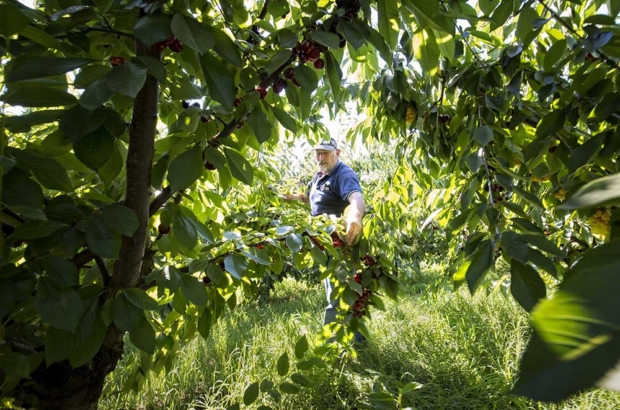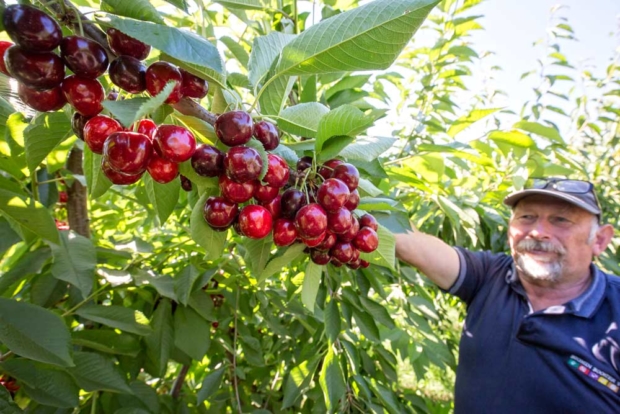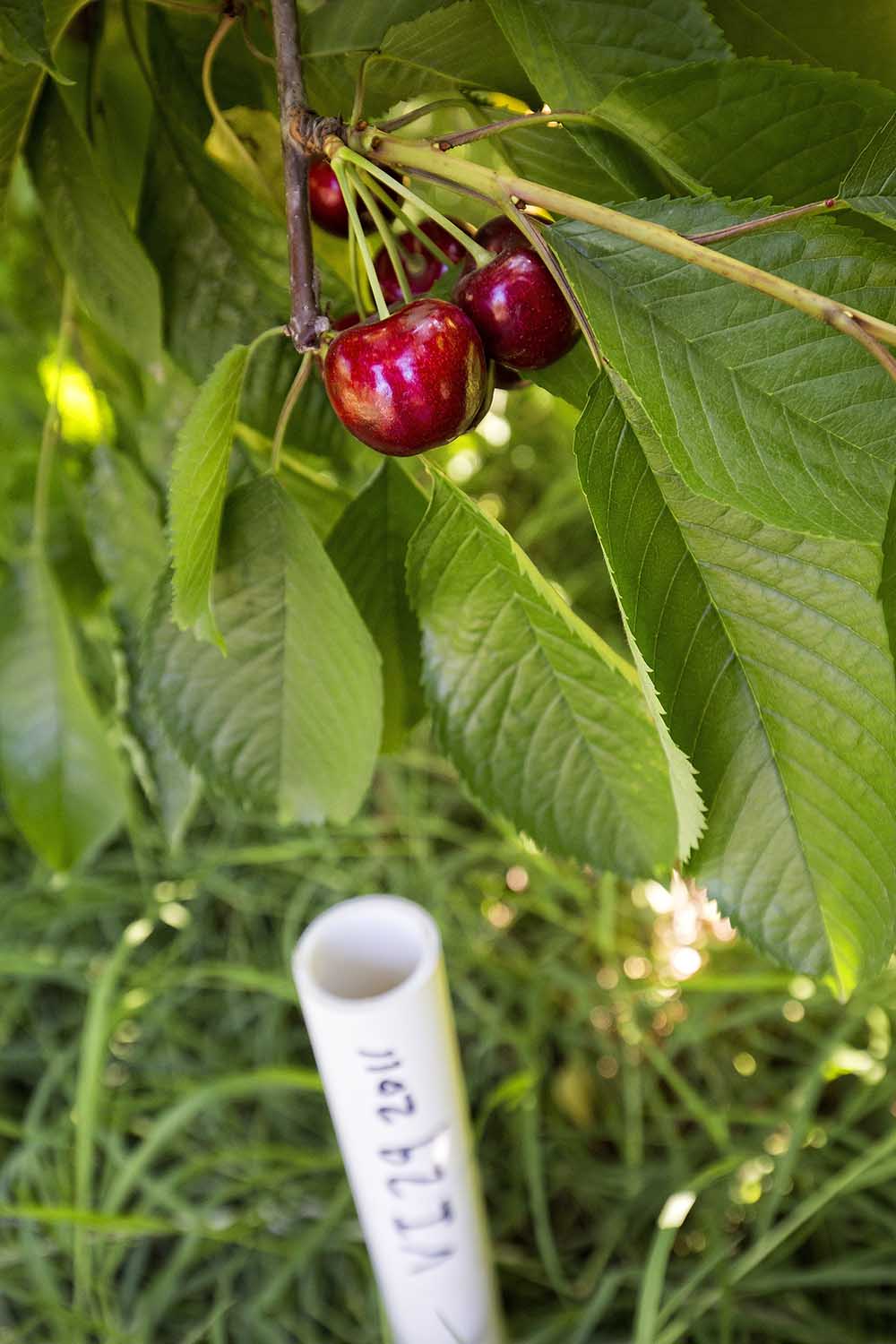
Variety Watch: Tamara
Note: This story has been updated to show that Franklin Trouw is a former director of OakSun Cherries. He had resigned his position with the company prior to the date this story was first published. Good Fruit Grower regrets the error.
A new cherry variety, bred in a Czech nobleman’s chateau, has Pacific Northwest growers tentatively excited.
Backers claim the Aramat, which carries the trade name Tamara in the United States, grows firm, sweet, juicy and large — very large.
Test plots in the Columbia Gorge region straddling the Columbia River produced cherries mostly in the 8.5-row to 9.5-row size range this year, a year otherwise known for small fruit.
Some Australian trial blocks have routinely produced fruit 32 to 34 mm in diameter, with some as large as 37 mm in diameter. A 9-row cherry is 33.3 millimeters.
“We don’t even have it on the chart,” said Dave Weil, owner of Varieties International, the Dundee, Oregon, limited liability corporation that holds the U.S. commercial license.
Still, Weil recommends caution. Sample sizes have been small and the U.S. trees are young; the U.S. patent was issued in June 2014, and the cherry has been commercially available for only three years.
He suggests larger growers plant only 10 or so commercial acres — small growers even less — until his company and collaborators gather more empirical data about fruit quality, postharvest characteristics and storability.
“In order to be sure a cherry can do what you want, because you’re asking it to do a lot, you have to test it longer,” Weil said. “You really can’t afford to make mistakes.”

History
The Tamara is a product of the Research and Breeding Institute of Pomology in Holovousy in the Czech Republic. Once an ornate chalet owned by Czech royalty, the Ministry of Agriculture turned it into a fruit research institute in 1951.
In 1997, after the fall of the Iron Curtain, a limited liability corporation took over management. Today, the facility is involved in nearly every aspect of the Czech fruit industry, including the breeding of apples, cherries, apricots and strawberries. The institute claims credit for 27 sweet cherry varieties.
Starting in 1995, a group of Columbia Gorge growers began touring Europe for new varieties to help make up for the declining processing market, said The Dalles grower John Morton, one of Weil’s first trial growers.
Their tours, often joined by friends from Australia, eventually took them to former Soviet Bloc nations. That’s where they found the VI-29, or Tamara. It’s a cross between a Van and a Krupnoplodnaja, a large, firm Ukrainian variety.
Oregon State University’s Extension planted trial blocks in The Dalles, Oregon, in 2013, several years after Weil and his growers planted trees.
In the research blocks, the Tamara averaged 31.7 millimeters this year, compared with 26.65 for Bing, Extension horticulturalist Lynn Long said. Last year, the Tamara averaged 32.6 millimeters compared with 29. Those figures make Tamara one of the largest cherries in Long’s Cemetery Block, an ongoing trial of 50 or so varieties nicknamed for a nearby graveyard.
Tamara has both high acidity and sugar levels, which equates to a flavorful cherry, he said. “That usually means that the flavor is very strong, and it’s usually a positive trait,” Long said. It also is firmer and more resistant to rain cracking and pitting than Bing, he said.
The only “yellow flag” he noticed was the stem: It took considerably less average force to pull stems from Tamara cherries than Bings.
Tendency to lose stems during picking and packing has doomed other varieties in the past, such as the Selah, which was otherwise a well-performing cherry, Long said. So far, Tamara hasn’t registered as sensitive to stem pull as Selah in his trials.
However, he cautioned that his data is preliminary.
“One or two year’s data, it’s not conclusive at that point,” Long said.

Grower reaction
About 10 growers have the cherry so far, but in early July, several from Oregon and Washington visited a block of 30 Tamara trees on a hillside outside of The Dalles to check out the new dark cherry. It was Weil’s first public promotion.
Among them was Jeff Cleveringa of Oneonta Starr Ranch Growers in Wenatchee, Washington. On paper, the Tamara selling points match what the industry’s export buyers want — large, dark, firm and “crunchy every time,” he said.
But time will tell growers more.
The cherry industry has a history of buying into variety hype only to be disappointed later, Cleveringa said, with Kiona a perfect example. “For the first five years it’s a great eating cherry. It’s firm, it’s big, it’s nice. And then as the tree settles down and matures, it just starts getting softer and softer and softer.”
Scott McDougall of McDougall & Sons likes what he sees so far from his own three or four Tamara test trees. The size and firmness reminds him of a Skeena, but Skeena cracks more easily in the rain. He plans to add 5 or 10 acres of Tamaras.
Only test blocks are allowed so far in Australia, said Franklin Trouw, an Australian grower who visits Oregon every year. Australian growers are interested because they seek a variety that doesn’t nose crack as easily in their conditions as Attica and Regina, he said. The Tamara may be the answer, he said. “In theory it had all the perfect credentials.” •
—by Ross Courtney






Hello,
Thank you for valuable post.
Could you share with information about the Ripening and blooming time of tamara. I have two varieties of cherry in my orchard lapens and sweetheart does tamara will pollinated buy this kind of cherries and vice versa.
Got a partial answer for you, courtesy Oregon State University extension: In 2020 at a trial block in The Dalles, Oregon, first bloom for Tamara was April 5, 5 percent bloom was April 8 and full bloom was April 11. Harvest was July 5. I’ll see what I can find out about the pollen compatibility.
Allele combination is S1S9 and suggested pollinizers are Selah, Skeena and Radiance Pearl, according to Ashley Thompson of OSU extension.
Hello
I am very appreciate for your support
regards